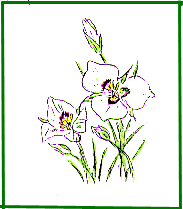Sego Lily




![]()
![]() The Tulip Branch of the Lily Family (Liliaceae) includes
Utah's State Flower, the Sego Lily (Calochortus nuttallii)
and the mariposa lilies. The name "mariposa" means butterfly, probably
referring to the bright, butterfly-like markings of its center. The true
sego lily is a white flower about two inches across. It has three large
petals, delicately tinged with yellow, brown, and purple, and having golden
nectar glands. The three light green sepals are lance shaped, sharp pointed
and about 2/3 as long as the petals. Before the flower appears, its
grass-like, grayish green foliage can be distinguished from that of the
poisonous Death Camas (Zygadenus) by having a "rounded
troughlike cross section of U-shaped leaves, in contrast to the sharply
V-shaped leaf of the Death Camas. In Utah, the Sego Lily attains up to a
foot in height, but its brightly hued cousin of the California desert may
grow to four feet in height. The scientific species name of the sego lily,
honors Thomas Nuttall, who discovered it in 1824 when on the Wyeth
Expedition to the Pacific Coast.
The Tulip Branch of the Lily Family (Liliaceae) includes
Utah's State Flower, the Sego Lily (Calochortus nuttallii)
and the mariposa lilies. The name "mariposa" means butterfly, probably
referring to the bright, butterfly-like markings of its center. The true
sego lily is a white flower about two inches across. It has three large
petals, delicately tinged with yellow, brown, and purple, and having golden
nectar glands. The three light green sepals are lance shaped, sharp pointed
and about 2/3 as long as the petals. Before the flower appears, its
grass-like, grayish green foliage can be distinguished from that of the
poisonous Death Camas (Zygadenus) by having a "rounded
troughlike cross section of U-shaped leaves, in contrast to the sharply
V-shaped leaf of the Death Camas. In Utah, the Sego Lily attains up to a
foot in height, but its brightly hued cousin of the California desert may
grow to four feet in height. The scientific species name of the sego lily,
honors Thomas Nuttall, who discovered it in 1824 when on the Wyeth
Expedition to the Pacific Coast.
![]()
![]() The sego lily saved the Utah pioneers from starvation in the difficult
period from 1847 to 1849, for the western Indians taught them to eat its
bulb-like root. In 1911, the state legislature made Calochortus
nuttallii the State Flower. In his "Founding of Utah", Levi Edgar
Young relates a very interesting Indian legend about its origin:
The sego lily saved the Utah pioneers from starvation in the difficult
period from 1847 to 1849, for the western Indians taught them to eat its
bulb-like root. In 1911, the state legislature made Calochortus
nuttallii the State Flower. In his "Founding of Utah", Levi Edgar
Young relates a very interesting Indian legend about its origin:
"Many, many suns ago, the Indians lived in great numbers in these valleys of the mountains. They grew corn and berries in rich abundance. As they increased in yield, the Indians became jealous of one another and tried to see who could gather the most food for winter living, when the snows were deep and cold. Then they warred. The game stick was replaced by the tomahawk. Many Indians were killed. The Great Spirit was displeased. He dried up the corn and berries. The children were left without food. The sky became dark with great clouds for many moons; the earth refused to yield; the sands blew over all the land. The Indians sorrowed and prayed to the Great Spirit. One day the sun shone bright up on the hills, and the people saw a little plant growing everywhere, even in the canyons and far above to the very peaks. The Great Spirit had heard the prayers of the people. When the Indians tasted the root, they knew the Great Spirit had saved them from death. Ever after, they refused to fight where the Sego Lily grew. They called it the 'Little Life Plant of the Hills'."